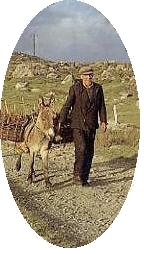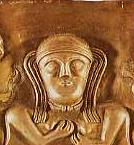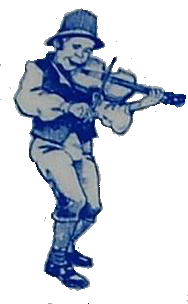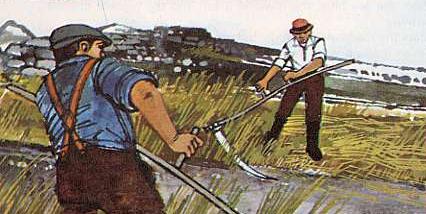|
| Ireland
is a small island in north western Europe it consists of 32 counties and
is divide into four provinces Ulster
Munster Leinster
and Connaught.
Six of Ulster's nine counties are ruled b North to south, the maximum length of Ireland is 486 km (302 mi); its extreme width is 280 km (174 mi). Malin Head, at latitude 55°27' north, and Mizen Head, at latitude 51°27' north, are, respectively, the northernmost and southernmost points on the island; easternmost and westernmost points are demarcated by longitude 5°25' west and longitude 10°30' west. Ireland is known the world over as the Emerald Isle because of the lush greenery of its vegetation particularly in the central low lands. The island is roughly rectangular in shape with the mountains and uplands concentrated around the perimeter while the center is dominated low and sometimes undulating farmland Ireland is called Eire in Gaelic, the ancient language of Ireland. Gaelic and English are the country's two official languages. Ireland also has long been known by the poetic name Erin. Erin go bragh is a well-known phrase in Gaelic that means Ireland forever. |
||
|
|
The
People |
||
|
Most of the population are descended from
peoples who settled in the country during the past 7,000 years. These
peoples included Celts, Approximately three-fifths of the Irish people live in cities and the large towns. The remainder live in small rural towns and villages and in the countryside. Only three Irish cities have more than 100,000 people Dublin, the capital of Eire and its largest city, and Cork. Belfast is the largest city in Northern Ireland and its capital. Throughout history Ireland has suffered from emigration, mainly because of limited job opportunities, many thousands of people left the country, particurarly during and after the great famine 1845-48 Most going to the United Kingdom. The United States although many went to South America and Australia. During most of the period since the 1920's, the growth of new industries in Ireland and the limited number of jobs available in other countries helped to check emigration. However the population increased from the 1960's. But economic problems and unemployment led to another increase in emigration in the 1980's. In 1972 Ireland joined the European Economic Community, which heralded an unprecedented period of economic growth, Ireland came to be called the 'Celtic Tiger' Today Ireland attracts immigrants mainly from eastern European countries. The Irish are considered to be friendly and warmhearted, they also have a well deserved reputation for hospitality, close family ties, and skill as writers, storytellers, and as musicians. |
||
|
|
Language. |
||
|
The
two official languages of Ireland are English and Gaelic.
All the people with the exception of a few older people on some of the
western islands, speak English. The Gaelic spoken in Ireland is derived from the ancient Celtic language, it is usually referred to as Irish. During the period when Great Britain ruled Ireland the language was suppressed and almost died out. Since Ireland became independent in the early 1900's, many Irish people have attempted to bring the language into wider use. Today, Irish schools teach Gaelic, as well as English. Approximately 30 per cent of the people can speak Gaelic well enough to use it in conversation. Gaelic is used as the everyday language in some of the more remote areas of the west and on some of the Islands.
|
||
|
|
| In
Irish cities and towns, most of the people live in houses. Others live
in flats, flat dwelling is increasing. Typical houses in The Roman Catholic Church has long played a major role in Irish social life. Almost every Irish city has a Catholic cathedral, and nearly all the towns and villages have a Catholic church. Most people attend church regularly. At their local church, the people join religious societies and take part in social gatherings and other activities. Catholic beliefs influence Irish law, for example, abortion is illegal in Ireland, until 1996, divorce was illegal. Many of the Irish enjoy visiting their neighborhood pub (public house). People gather in pubs to drink beer and whiskey, talk with friends, and listen to music. Large numbers of young people in Ireland once remained single and lived with their parents until they were over the age of 30. Farmland and jobs were scarce, and few young people could afford to marry and raise families. Today, young people, especially those in cities and towns, are marrying earlier. |
||
|
|
The First Potatoe in Ireland.
|
||
|
Irish cooking
is simple. Principal foods include beef, bread, chicken, mutton, pork,
and potatoes. Potatoes grow well in the country's One of Ireland's most famous dishes is Irish stew. It is made by boiling layers of potatoes, onions, and pieces of mutton in a covered pot. Another traditional meal consists of boiled salt pork, cabbage, and potatoes. The favorite alcoholic drink in Ireland is stout or Guinness. The Irish use barley malt to make Irish whiskey, a world-famous alcoholic drink. A drink called Irish coffee is made with coffee, Irish whiskey, brown sugar, and cream. |
||
|
|
Education.
|
||
| Irish law requires children between the ages of 6 and 16 to go to school. Nearly all of southern Ireland's schools are controlled by private organizations, chiefly the Roman Catholic Church. But the Irish government provides funds to support the schools, and most primary and secondary education is free. Most secondary schools in the south are either boys' schools or girls' schools, in the north most of the schools have both boy's and girl's. A minister of education supervises the government's role in the educational system, north and south. For many years, Ireland has had separate secondary and vocational schools. Secondary schools provide general education, and vocational schools offer technical and general training. In some areas, comprehensive schools and community schools have been set up to provide both types of education under one roof. Southern Ireland has four universities Dublin City University, the University of Limerick, the National University of Ireland, and the University of Dublin. The National University, which has colleges in Dublin, Galway, and Cork, has a total enrollment of about 30,000 students. It also has six other recognized (associated) colleges in Ireland. One of them, St. Patrick's College in Maynooth, includes the national seminary for the Roman Catholic Church. The University of Dublin, also called Trinity College, has about 10,000 students, plus four recognized colleges. Northern Ireland has ? universities Queens University Belfast, The Ulster University Jordanstown, |
||
|
|
The
Climate. |
||
| Ireland has a mild, wet climate. Temperatures average about 5 °C in winter and about 15 °C in summer. Ireland's climate is influenced by the North Atlantic Current, a warm ocean current that flows north past Ireland. This current is an extension of the Gulf Stream It also helps warm the waters around the Western Isles of Scotland. In winter, westerly winds blow across the current and bring warmth to the country of Ireland. Ireland lies farther north than the New England states of the United States. But winters in Ireland are warmer than those in New England, partly because of the North Atlantic Current. In summer, ocean waters are cooler than the land, and westerly winds blowing across the waters help keep temperatures mild. The ocean winds also bring much rain to Ireland. The heaviest rains fall in the mountainous regions along the west coast. The rainfall there averages about 110 centimeters a year, with some areas having as much as 300 centimeters a year. The eastern lowlands have about 75 centimeters of rain a year. The southern and western parts of Ireland have the longest growing season of any country in the islands making up the United Kingdom and Ireland. This is because of their mild climate and plentiful rainfall. In many areas, pasturelands can be used throughout the year. See also our climate page. |
||
|
|
Economy
|
||
| The economy of Ireland depends heavily on service industries and manufacturing. For centuries, nearly all the Irish people made their living from farming. But since the 1920's, agriculture has been declining in importance, while the country's manufacturing and service industries have been increasing in importance. Natural resources. Ireland's most important natural resources are the soil and pastures of its lowlands. The country has deposits of lead, zinc, and marble and other building stone. One of the world's largest lead-zinc mines is near Navan. Peat is an important domestic fuel. Ireland has little coal, but natural gas has been found off the southern coast. Coal, oil and natural gas account for 79 per cent of the electricity generated in Ireland, peat 15 per cent, and hydroelectricity 6 per cent. Forests once covered much of Ireland, but most were cut down for timber or to clear land for farming. Since 1922, the government has planted more than 300,000 hectares of forest. Service industries are those economic activities that produce services, not goods. Service industries taken together account for more than half of the value of Ireland's economic production. More than half of Ireland's workers are employed in service industries. The most valuable service industries in Ireland are wholesale and retail trade; and community, social, and personal services. Community, social, and personal services include such activities as education, health care, and tourism. Trade, transportation, and communication also contribute heavily to Ireland's economy and employ much of the workforce. Ireland attracts many tourists and their spending benefits several service industries. |
||
|
|
Manufacturing.
|
||
| Ireland has few heavy manufacturing industries. Small and medium-sized factories and workshops produce most manufactured goods. Many factories are in the Dublin and Cork areas. Ireland's manufactured goods include alcoholic beverages, chemicals, clothing, computers and other electronic equipment, machinery, medicines, metal products, paper, printed materials, processed foods, and textiles. The Irish government follows policies designed to develop the nation's industries. It welcomes foreign industry in Ireland and encourages the manufacture of goods for export. |
||
|
|
| Agriculture
and Fishing. The waters along Ireland's coasts are excellent fishing grounds. The principal fish and shellfish caught in Irish waters include cod, haddock, herring, lobsters, mackerel, plaice, prawns, rays, salmon, and whiting. Recent fuel price rises (2005) will undoubtedly impinge on the profitability of the country's fishing fleet, particularly the larger vessels. For Details of sea angling around
the Irish coast visit this
page. |
||
|
|
Transportation.
|
||
| Ireland has a good road and rail network. The country has an average of about one car for every four people. Dublin Airport is the nation's busiest airport. Shannon Airport, near Limerick, handles many transatlantic flights. The north has two airports Belfast International airport near Antrim and Belfast city airport on the southern shore of Belfast Lough. The ports of Cork, Dublin, Limerick, Rosslare, and Waterford handle most of southern Ireland's foreign trade. The Ballinamore and Ballyconnell Canal links the Erne River in Northern Ireland with the River Shannon in the Irish Republic. Northern Ireland's main ports are situated at Belfast and Larne they run high speed and conventional ferries to the UK mainland and Scotland. Warrenpoint on Carlingford Lough handles mostly freight traffic. Trading
Partners.
|
||
|
|
Press
& Media. |
||
| Ireland has many daily and weekly newspaper's, the largest of which is the Irish Independent of Dublin. The Irish constitution guarantees freedom of the press. The government funds the main radio and television networks. Local radio stations are privately owned. Almost all Irish families own a TV set and one or more radios. Television owners pay yearly license fees to help support the government TV and radio agency, Radio Telefis Eireann (RTE). Government-supported companies run the postal and telephone services. |
||
|
|
 y
Great Britain, these six counties amount to about one-sixth of the total
land area of Ireland. The total area of the island is 83,765 sq km (32,342
sq mi) of which the Republic of Ireland is 70,282 sq km (27,136 sq mi)
in extent, and Northern Ireland 13,483 sq km (5,206 sq mi).
y
Great Britain, these six counties amount to about one-sixth of the total
land area of Ireland. The total area of the island is 83,765 sq km (32,342
sq mi) of which the Republic of Ireland is 70,282 sq km (27,136 sq mi)
in extent, and Northern Ireland 13,483 sq km (5,206 sq mi). Vikings, Normans, and the British. Each successive group added their particular
influence which shaped the character of the Irish people.
Vikings, Normans, and the British. Each successive group added their particular
influence which shaped the character of the Irish people. 
 Ireland
are built of brick or concrete and have four to seven rooms. In rural
areas of Ireland, modern houses have replaced most of the traditional
thatch-roofed cottages, the few remaining are now tourist attractions.
Ireland
are built of brick or concrete and have four to seven rooms. In rural
areas of Ireland, modern houses have replaced most of the traditional
thatch-roofed cottages, the few remaining are now tourist attractions. climate
and have been an important food in Ireland since they were introduced
by
climate
and have been an important food in Ireland since they were introduced
by 
 feed the nation's people and also for export, although some food is imported.
Ireland's major agricultural products include barley, beef and dairy cattle,
hay, pigs, milk, potatoes, poultry, sheep, sugar beet, and wheat. The
country rears some of the world's finest cattle and horses.
feed the nation's people and also for export, although some food is imported.
Ireland's major agricultural products include barley, beef and dairy cattle,
hay, pigs, milk, potatoes, poultry, sheep, sugar beet, and wheat. The
country rears some of the world's finest cattle and horses.